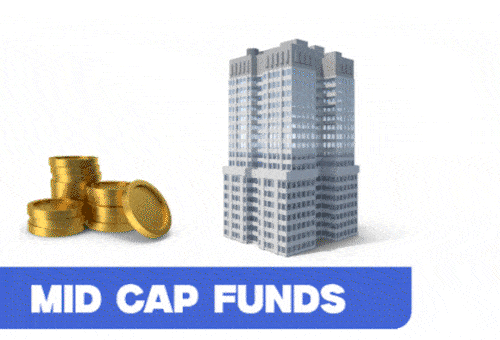Understanding MidCap Cap Mutual Funds
Midcap funds invest in medium-sized companies by market capitalisation in India. These funds offer relatively higher returns compared to large-cap funds. As per regulations, mid-cap funds should invest at least 65% of their assets in mid-sized companies.
Mid-cap funds offer higher returns as the underlying companies can grow as the next market leaders.
These funds are relatively more volatile than large-cap funds.
Held for at least 7 years.

Top schemes of Mid Cap Mutual Funds
| Fund Name | Returns | Actions | ||
|---|---|---|---|---|
| 1 Year | 3 Year | 5 Year | ||
Returns calculator
Total Invested : ₹ 6,00,000
Profit : ₹ 56,200,000
Current value : ₹ 1,16,20,000
Frequently Asked Questions
Which is the best midcap mutual fund?
To select the best midcap fund, you should define the factors like:
Goals like a car, a house, retirement, etc.
Time to achieve the goals
Risk or volatility, you can handle
Are mid-cap funds safe?
Mid-cap funds are not inherently safe in the way that fixed deposits or debt funds are. However, their risk-reward balance lies between large-cap and small-cap funds. Here is a breakdown of their safety aspects:
How do I choose a midcap fund?
To choose a midcap fund, look at past returns or star ratings. Here is a practical approach to it:
Understand the fund manager's philosophy
Focus on rolling returns for consistency
Compare downside protection vs. upside capture to check performance in up-market and down-market
Check the fund's size for flexibility and stability
Expense ratio vs. alpha generation
What is the difference between large-cap and mid-cap mutual funds?
Large-cap funds invest in the top 100 companies according to the market cap mandated by SEBI, while Mid-cap funds invest in the 150 companies ranked 101 to 250 according to the market cap.
Is it good to invest in midcap?
Yes, it can be much more rewarding as these offer a higher scope for returns than large-cap counterparts. The midcap companies strive to become the next market leaders. However, the underlying companies are relatively less stable, hence they may fall more during volatility.
Is midcap high risk?
Yes, mid-cap funds are high risk, though they are generally less risky than small-cap funds and riskier than large-cap funds.
Who should invest in midcap mutual funds?
Those who can handle the short-term volatility
Someone who wants to invest in the upcoming market leaders
Investors who already have large-cap exposure & need to diversify
Growth-oriented investors who can take additional risk
Those who want to invest for over 7 years